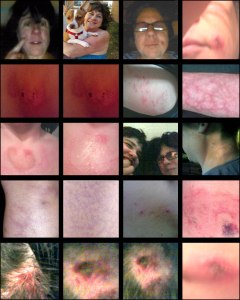The SUN: Sunshine on my shoulder does not make me happy! LOL- Some of us with lupus are very sensitive to UV rays from the sun. Our bodies respond to the sun as an attack-and send too many fighter cells to the skin that overdrives our immune system and causes damage. I personally break out in itchy hives, vascular lesions, pemphigoid rashes, discoid spots, red hot malar rashes, scleroderma skin hardening and & it takes me months to recover.
Also-later our bodies cannot get rid of the dead cells-it’s a slow process-not the kind of recovery after sunburn kind of thing. My solution? Stay inside as much as possible. I picked up a titanium umbrella at coolibar.com. Here is some info from the LFA on the importance of being safe in the SUN!
UV Exposure: What You Need to Know
By Stephanie Watson
We talk a lot about the damaging effects of the sun’s ultraviolet (UV) rays. And we know how to protect ourselves outside with wide-brimmed hats, garments made from sun-protective- fabric, and, of course, sunscreen. But for some people with lupus, whether they’re walking through a supermarket or sitting in an office, the UV exposure from artificial light can be just as damaging and painful as too much time outside in the sun.
That’s why Hanan Hameen-Smith covers her skin in sunscreen and cloaks herself from head to foot in clothing when she leaves her house. “When I go to the gym for physical therapy, I have to wear sunglasses and a hat,” says the 33-year-old dance teacher, who lives in New Haven, CT. This elaborate costume often makes onlookers stare, she says. At home, she keeps the blinds closed and the lights dimmed. Turning off the lights and closing the blinds aren’t options when she teaches, so Hameen-Smith wears a hat then, too.
Hameen-Smith has lived under these conditions since 2010, when she was diagnosed with lupus. The disease has triggered a photosensitivity so severe that any exposure to UV light leaves a red, itchy rash on her skin. “It’s changed my whole life,” she says.
Why So Sensitive?
Exposure to UV light causes damage to everyone’s cellular DNA, explains Sabrina Newman, M.D., assistant professor of dermatology and internal medicine at George Washington University in Washington, DC. “UV radiation is what causes cell damage, regardless of whether it’s coming from the sun or a lamp,” she says.
It’s what happens next that differs. “In people with lupus, the cells are much more sensitive to the damage caused by UV radiation,” Newman says. “Once the cells are damaged, the immune system clears them, but people with lupus have a much slower clearance of these cells.”
The dead cells stick around in the body, triggering an immune system attack. “We have antibodies in our immune systems that typically are used to fight infection. But in people with lupus, the antibodies wrongly target proteins within normal cells and cause an immune reaction,” explains Benjamin Chong, M.D., assistant professor in the Department of Dermatology at the University of Texas Southwestern Medical Center in Dallas.
And photosensitivity is common in people with lupus: 40 percent to 70 percent of people with lupus will find that their disease is made worse by exposure to UV rays from sunlight or artificial light. Although the sun emits much larger amounts of UV radiation than indoor light, most people—especially those with lupus—tend to spend more time indoors, where they’re exposed for longer periods of time.
That’s not all: UV light can also activate lupus flares, triggering symptoms like fatigue, joint pain, tingling, and numbness.
When Ellen Schnakenberg ventures outside, her skin breaks out in a sunburn-like rash from UV exposure. Then she gets so ill that she has to retreat to her bed. “I’ll have a flare that will last for a couple of days to several weeks,” says the 49-year-old from Unionville, MO.
Cover Up
If UV light flares your lupus, you want to create a barrier between you and it:
- Apply a liberal layer of a 30 SPF or higher sunscreen, one that provides broad-spectrum- protection against both UVA and UVB rays.
- Wear tightly woven clothing that covers your skin, a wide-brimmed hat, and wraparound sunglasses to protect you from head to toe.
- Choose light bulbs that have the lowest possible irradiance (intensity).
- Cover fluorescent and halogen bulbs with light shields or glass that filters out UV rays. Look for shields with readings of 380 to 400 nanometers, which filters all types of ultraviolet light.
- Use UV-blocking shades to cover windows and prevent sunlight from streaming in.
- Consider tinting the windows of your car—check state laws on window tinting to see if a doctor’s note is required.
Cause and Effect
Some medicines can make you more photosensitive, too. Talk to your pharmacist or physician about the drugs you’re taking, especially:
- Antibiotics, such as doxycycline (Doryx®) and tetracycline (Ala-Tet®, Panmycin®, Sumycin®)
- Anti-inflammatory drugs, such as ibuprofen (Advil®, Midol®, Motrin®, Nuprin®)
- Blood pressure medications, such as hydrochlorthiazide (HydroDIURIL®, Microzide®) and lisinopril (Prinivil®)
Methotrexate can also make some people more UV-sensitive. Yet stopping this medicine if it’s helping your lupus can be tricky. “That’s something you’d need to discuss with your doctor,” Chong says.
Another lupus medicine has the opposite effect. “Hydroxychloroquine (Plaquenil®) is actually protective,” Newman says. “Doctors will prescribe it for people who have photosensitivity.”
Change It Up
When you’re photosensitive, life requires a few modifications. Hameen-Smith has done everything from changing her sunglasses prescription to putting lower-wattage light bulbs in all of the lamps in her home. Tee Brown, 44, asked the Oklahoma City Fire Training Center, where she works as an office specialist, to make a few alterations to limit her exposure. Diagnosed with lupus and fibromyalgia in mid-2012, she noticed that the lights in her office were causing headaches and problems with her vision while working on her computer. “One of the solutions was to take out some of the lights above my desk,” she says. “It has worked a little bit, but not 100 percent.”
Schnakenberg also does what she can. She wears UV-protective long-sleeved shirts and pants, and she puts on sunglasses both inside and outside to shield her eyes from UV light. She has also applied UV-protective film to the windows of her house and tinted the windows of her car.
Schnakenberg is even bringing along her own incandescent light bulbs when she and her husband take a 30th-anniversary cruise to Alaska this summer. “You can’t stop life. You have to make choices,” she says. “I pick and choose the things I do, knowing there will be a price to pay, but hoping the price won’t be too high.”
More at the Lupus Foundation of America website HERE–




